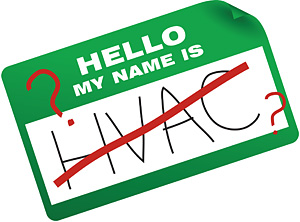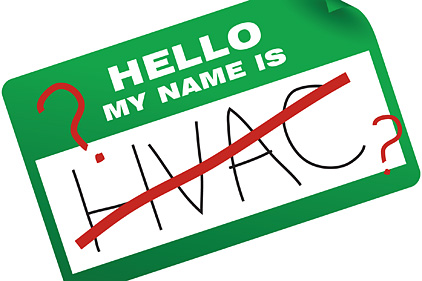 As they continually strive to find ways into customers’ homes, HVAC companies are facing challenges from all angles. Conglomerates including Google, AT&T, and Comcast are now competing for the same work historically completed by HVAC contracting businesses.
As they continually strive to find ways into customers’ homes, HVAC companies are facing challenges from all angles. Conglomerates including Google, AT&T, and Comcast are now competing for the same work historically completed by HVAC contracting businesses.
No matter how big the foe, the HVAC industry is not backing down. Contractors are taking steps to better position themselves before consumers, and industry associations are diversifying their offerings in an effort to keep up with an ever-changing marketplace.
As the times are a changing, it begs the question: Does the HVAC industry need to rebrand itself?
Who’s in Control?
“What I’m concerned about is we have a lot of outside forces competing for control of our industry,” said Dave Kyle, ACCA chairman, and general manager, Trademasters Service Corp., Lorton, Virginia. “If we establish ourselves more as the indoor environment and energy-efficiency industry, it helps defend ourselves against — or put up a good offense against — the alarm companies, utilities, and all these outside forces that want to gain, or even covet, the relationships we have with our existing customers. We are already in the home, and that’s a really powerful advantage to have.”
Kyle said the HVAC industry must establish itself as the authority on energy-efficiency regulations.
“We have to make sure we’re the ones in front of the legislature helping make decisions about energy in the home, efficiency of appliances, and complete home issues,” he said. “This has to be our No. 1 challenge going forward. We must fend off other people vying for control of our industry.”
That challenge is a big one for the industry, said Steve Lauten, president, Total Air & Heat Co., Plano, Texas. He suggests the industry has evolved to a point where we are better described as providers of indoor comfort, controls, and automation, noting elected officials are allowing security and alarm companies to change thermostats with no training or skills.
“As an industry, we are at a junction in the road that will determine our future role in servicing and installing residential and commercial comfort systems, controls, and IAQ,” Lauten said. “This is not something we can sit back and watch it develop. We know security and cable companies are investing in these areas, we know Google bought Nest, and we know many other companies are looking at these options when refrigerators connect to the Internet. While not ready for an acronym, I think it’s fair to say, as an industry, we are the most knowledgeable, skilled, and trusted providers for indoor comfort, health, safety, and security. It’s our job to provide comfort systems that meet those needs while impacting the outdoor environment minimally.”
Finding ways to reach younger customers who might not just automatically dial up their local HVAC contractor has been another one of those challenges. Whether it be through social media, YouTube, or apps, Butch Welsch, president, Welsch Heating & Cooling, St. Louis, noted adults aged 25-45 are going to be a major focus of the industry for a next several years.
“That group of people doesn’t look at the Yellow Pages or read newspapers; they get their news on their phones,” said Welsch. “Their whole means of communication are entirely different. They look for contractors, or people to do business with, differently than their predecessors. It’s a whole new ballgame as far as our industry is concerned.”
Reaching new customers is certainly an extremely important aspect of the equation, but, as contractors, are we standing in our own way? That question was posed by Ray Isaac, president, Isaac Heating & Air Conditioning Inc., Rochester, New York.
“This industry has an identity crisis, and we are our own worst enemy,” he said. “There’s nothing wrong with being a contractor, but there’s a whole different mindset when you approach something as a contractor as opposed to a professional businessman that does contracting. The things professional businesses do lend themselves very well to people who are doing contracting. If you can apply both of them, you have a dynamic model there. It’s been promoted in our industry for years.”
That said, Randy Novak, president, Novak Heating & Air Conditioning, Hiawatha, Iowa, and president of the Sheet Metal and Air Conditioning Contractors’ National Association (SMACNA), said he thinks it’s a good idea for the industry to take a hard look at itself on a regular basis.
“The contracting business today is much different than when I first got started,” Novak said. “It is more than just installing a furnace or a condensing unit right now. We are looking at achieving total system performance and verifying that performance.”
Training and Teamwork
Paul Stalknecht, president and CEO, ACCA, said change is essential and occurs naturally within the HVAC industry noting that a sweeping rebranding is not going to occur overnight. Contractors need to sell themselves as indoor environment professionals, he said, because they are just that, and the knowledge one now needs goes well beyond just switching out a box.
“There is a lot of work still to be done to change the perception of what our industry does,” Stalknecht said. “The good news is that the shift has happened within the industry and contractors are embracing it. The next step is to educate consumers and get them to fully understand that our industry has the solutions to their comfort problems, and those solutions extend beyond air conditioners and furnaces.”
Stalknecht added the threat to HVAC contractors comes from the alarm companies selling integrated services without a basic understanding of HVAC systems — something ACCA is working to curb.
“They would like to sidestep local or state laws that prohibit them from installing thermostats without a license,” Stalknecht said. “There have been a couple of states that have had bills come up that would change the laws to allow these companies to perform these duties, and ACCA and its industry partners have worked together to encourage those states to reject these bills. We are actively fighting to keep our contractors in people’s homes to perform the work, because they are the ones qualified to do the job.”
Jack Tester, president and CEO, Nexstar Network, said it all comes down to who the homeowner is going to trust — but contractors, as a whole, need to hold their ground against this sudden surge in competition. He said Nexstar is all-in to help its members, and is making huge investments in both live classroom and online training.
“We must never cede the primary position as the HVAC experts. We can’t become subcontractors to other entities homeowners may be tempted to call for service or replacements,” Tester said. “Will homeowners ever trust Google or another monitoring company to replace a service provider in their homes? That is the million dollar question.”
Those involved in training the industry have decided to take a proactive approach.
John Lanier, COO, North American Technician Excellence (NATE), said the HVAC industry will continue to respond to each challenge as it occurs. Acknowledging there’s power in numbers, Lanier said NATE is teaming up with others in the industry to make sure contractors and technicians are ready to meet these hindrances head-on, including working with RESNET, ACCA, and the U.S. Environmental Protection Agency’s Energy Star program to create new certifications as needed.
“It’s our goal at NATE to work with manufacturers, distributors, and others committed to indoor environment quality to ensure NATE-recognized training courses reflect new products and services to meet homeowners’ demand for IAQ and comfort,” Lanier said.
Talbot Gee, executive vice president and COO, Heating, Air-conditioning & Refrigeration Distributors International (HARDI) said HVAC companies have to work hard at not making themselves irrelevant, and noted the entire industry is slowly professionalizing as it rapidly matures and competition increases.
“Every aspect of the HVACR supply chain needs to continually develop, articulate, and quantify its value to its core channel partners and to your customers,” Gee said. “If you can do these things, outside influences become opportunities more than threats. Our channel needs to continue to get smarter, more efficient, and more nimble, and I’m extremely confident that our leadership at HARDI is guiding our members and the organization in the right direction to do just that. One hundred percent of today’s HVACR companies, distributors included, will not be here in five years, but we believe HARDI is helping to define which kinds of distributors will be here far beyond the next five years.”
By taking part in this change, contractors are affording themselves the opportunity to compete in the future, and it’s why the best contractors are always investing in training and continuing education, Stalknecht said.
“By not selling themselves as indoor environment professionals they are missing out on potential business opportunities for growth far into the future,” Stalknecht said.
Making the Move
Not everyone thinks the industry needs to rebrand itself. Jeff Laski, chairman, S&M Heating Sales Co., Southfield, Michigan, said his region isn’t clamoring for all the bells and whistles of IAQ, energy efficiencies, and other options.
“We have only seen marginal increases to date, but we are watching the trends and will adjust accordingly,” Laski said.
As time rolls on, and this evolution becomes clearer, there’s no doubt in Isaac’s mind it is going to thin the contracting herd, so to speak.
“If nothing else, it’s either going to improve you, or delete you,” Isaac said. “A herd becomes stronger when the lions are going and picking off the weak, then there’s more food for the strong. I’m not trying to be crass, but it’ll be another test of the fittest for our industry.
“If you’re going to compete in the big leagues, you’re going to have to position your company to be up there. I welcome that type of element because we’re all just going to have to raise our games.”
Welsch said it is absolutely imperative that HVAC contractors begin to market themselves as indoor environment experts, but noted it won’t be an easy process, and it won’t occur upon the snap of a finger.
“Change is difficult. Try folding your arms and then doing it the other way,” Welsch said. “It’s imperative for contractors to change their way of thinking. Those that do are definitely going to have a step on those that don’t. It’s a whole different ballgame we’re operating in. The people are different, the market’s different, and what they’re looking for is different. They look for different things in the products they buy, and it’s a big learning curve for those of us — shall we say mature, rather than old — in the business to get used to.”
That’s why Kyle said this branding concern is his No. 1 priority during his term as ACCA chairman.
“HVAC makes it sound like a component of a building, but establishing ourselves as the environmental and energy experts makes us more than a component of it, it makes us the authority,” Kyle said. “This is what we do every day, and, until recently, we didn’t have people vying for this position, but now we do.”
SIDEBAR: Upcoming Industry Events
Sept. 17-19: Nexstar Network Super Meeting, Phoenix
Oct. 7-8: ACCA Building Performance Forum, Charlotte, North Carolina.
Oct. 8-10: PHCC Connect 2014, New Orleans
Oct. 9-10: ACCA Service Managers Forum, Charlotte, North Carolina.
Oct. 12-15: SMACNA Annual Convention, San Antonio, Texas
Jan. 26-28: AHR Expo, Chicago
Different organizations also regularly host free informational webinars. For more industry events, visit www.achrnews.com/events.
Publication date: 6/2/2014
Want more HVAC industry news and information? Join The NEWS on Facebook, Twitter, and LinkedIn today!



Report Abusive Comment